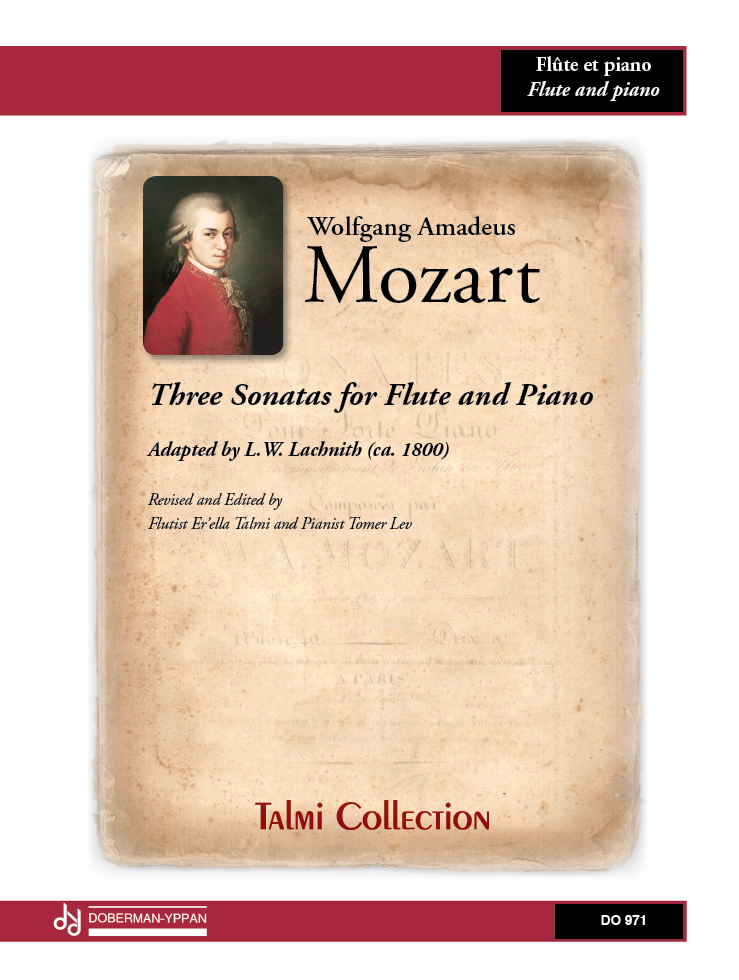3 Sonatas
Description
Adapted by L.W. Lachnith (ca. 1800)
Revised and Edited by Flutist Er'ella Talmi and Pianist Tomer
Lev
The three sonatas by Mozart had been discovered by the late American pianist Malcolm Frager. The manuscript, published in the early 19th century by Sieber-Paris, was found by Mr. Frager at a second-hand bookstore in the former Czechoslovakia and presented as a gift to his friend, Flutist Er'ella Talmi. The following title, originally in French, appears on the manuscript's cover: Three Sonatas for Piano with accompaniment of Flute or Violin composed by W.A. Mozart. These compositions are excerpts from the composer's pieces, adapted for Piano and Flute or Violin by Lachnith.
An examination of the material shows that these "Sonatas" are actually arrangements of Mozart's best-known chamber works and are derived from:
- Sonata no. 1 - Quintet for Piano & Woodwinds in E flat Major, K. 452.
- Sonata no. 2 - Quartet for Piano & Strings in g minor, K. 478.
- Sonata no. 3 - Trio for Clarinet, Viola and Piano in E flat Major, K. 498 (Kegelstatt Trio).
All three pieces had been arranged for Flute (or Violin) & Piano by Mozart's contemporary, Bohemian composer Ludwig Wenzel Lachnith (1748-1820). Lachnith was a Horn player and a composer, who, during his early years, had also studied Violin and Harpsichord. He wrote a few concerti, symphonies, music for the theatre and chamber works. He was a prolific arranger, who transcribed music written by Haydn, Mozart, Pleyel and other contemporaries for Piano, with or without additional instruments.
In those days it was a common trait to arrange popular pieces for a variety of instrumental combinations, according to market demands and commissions. Patrons commissioned tailor-made arrangements either for their own use or for the use of their court players, whereas amateurs bought it for in-house music making. At a time when there were neither radio nor recordings, playing a piece oneself was the only way to enjoy it in domestic context.
Today we are familiar with numerous works by Mozart and Haydn that have undergone various metamorphoses from the original instrumental settings to alternative ones. Moreover, many contemporary composers incorporated thematic materials borrowed from their own compositions (as Mozart did as well). The market was much more open, flexible and imaginative and adaptations of every sort were in high demand - sometimes no less than the originals.
An important feature of these arrangements was the adaptation to local style. Thus, in many countries, the arrangers had to re-design the pieces according to the taste of local audiences. In this context we can explain the liberties that Lachnith took in arranging these three masterworks by Mozart. As he worked for a considerable period of time in France, he was highly familiar with the French public that, compared with German audiences, required a lighter approach to music. Thus, in addition to necessary alterations implied by the new instrumentation, Lachnith shortened some of the longer movements, added quite a number of fashionable ornamentations and even - in the case of K. 478 and K. 498 - fully omitted altogether the slow movements, so that the French do not get bored.
In preparing the first modern edition of the Mozart-Lachnith Sonatas our intent was to follow Lachnith's original version while indicating by broken lines some of Mozart's original phrasings.
We feel that these three Sonatas will significantly enrich the repertoire for Flute & Piano. As Mozart did not write any of his mature pieces for this widespread ensemble, this edition will enable flutists to fill in for this deplorable lacuna.
Er'ella Talmi and Tomer Lev
